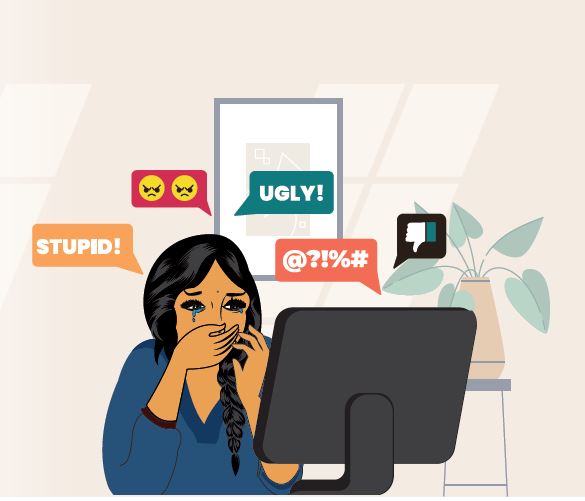 About Cyber Bullying
About Cyber Bullying
Cyber bullying is intimidating online behaviour, wherein you can be targeted on an online public platform with threatening, humiliating, embarrassing and harassing posts or acts.
Cyberbullying which happens among kids that take place using electronic technology. It can be carried out through electronic technology includes devices and equipment such as cell phones, computers, and tablets as well as communication tools including social media sites, text messages, e-mail, chat rooms, discussion groups and websites in Internet. Cyber bullying can include teasing and being made fun of, spreading rumors online, sending unwanted messages and defamation.
Examples of Cyberbullying include mean text messages or emails, rumors sent by email or posted on social networking sites, and sending embarrassing pictures, videos, websites, or fake profiles.
Why should we be concerned?
The act of cyber bullying not only hurts the child emotionally but they are prone being targeted in group online and offline leading to social isolation, harassment, mental stress that may even lead suicidal attempts.
Few pointers / warning signs to indicate that the child is victimized
- Recurrent health issues and not eating well
- Avoiding school or college and isolating self
- Felling depressed, sad, worried, agitated
- Loosing interest in doing any activities
Cyber Bullying: Risk Factors
cyberbullyBullying can happen anywhere, but depending on the environment, some groups may be at an increased risk. Learn what factors increase the risk of children being bullied or children more likely to bully others and what warning signs can indicate that bullying may be happening. You can also find out how bullying can negatively impact kids. No single factor puts a child at risk of being bullied or bullying others. Bullying can happen anywhere—cities, suburbs, or rural towns. Depending on the environment and socially isolated youth—may be at an increased risk of being bullied.
In order to prevent cyberbullying it is important to recognize the risk factors and which members of our youth are more likely to be targeted for cyberbullying than others. By recognizing these risk factors we can better prepare and educate youth about the dangers of cyberbullying and how to protect one self.
Social Networking
Cyberbullying has increased with the rising popularity of social media, online chat rooms, blogs and personal websites. Social networking cannot be totally blamed for the actions of cyberbullies. While social networking sites may provide a medium with which cyberbullies attack others, the site itself did not create the bully nor did it encourage the behaviour. A bully is still a bully whether they exist in the online realm or in the physical world. That being said, youth who participate in social networking sites or post personal information on websites or blogs are more likely to be cyberbullied. One way to prevent cyberbullying is to adjust your account settings to private to avoid unwanted visitors seeking private information.
Gender
According to the Cyberbullying Research, girls are more likely than boys to experience cyberbullying. Girls are also more likely to engage in cyberbullying behaviour such as posting unwanted photos of others online and using social networking sites to embarrass others. Girls are not the only ones guilty of cyberbullying though. According to their research more boys than girls admitted to sending emails to ridicule or anger others.
Tip : The cyber world is open to all. Anyone can post data on Internet. Beware of false information
In gaming
Sexual harassment as a form of cyberbullying is common in video game culture. A recent study says that this harassment is due in part to the portrayal of women in video games. This harassment generally involves slurs directed towards women, sex role stereotyping, and overaggressive language.
Children at Risk of Being Bullied
Generally, children who are bullied have one or more of the following risk factors:
- Are perceived as different from their peers, such as being overweight or underweight, wearing glasses or different clothing, being new to a school, or being unable to afford or cope up with peer children
- Are perceived as weak or unable to defend themselves
- Are depressed, anxious, or have low self esteem
- Are less popular than others and have few friends
- Do not get along well with others, seen as annoying or provoking, or antagonize others for attention
However, even if a child has these risk factors, it doesn’t mean that they will be bullied.
Children More Likely to Bully Others
There are two types of kids who are more likely to bully others:
- Some are well-connected to their peers, have social power, are overly concerned about their popularity, and like to dominate or be in charge of others.
- Others are more isolated from their peers and may be depressed or anxious, have low self esteem, be less involved in school, be easily pressured by peers, or not identify with the emotions or feelings of others.
Children who have these factors are also more likely to bully others:
- Are aggressive or easily frustrated
- Have less parental involvement or having issues at home
- Think badly of others
- Have difficulty following rules
- View violence in a positive way
- Have friends who bully others
Remember, those who bully others do not need to be stronger or bigger than those they bully. The power imbalance can come from a number of sources—popularity, strength, cognitive ability—and children who bully may have more than one of these characteristics.
Cyberbullying Effects
- Emotional distress: anger, frustration, embarrassment, sadness, fear, depression
- Interference with school work or job performance
- Quit job, drop out or switch schools
- Delinquency and violence
- Substance abuse
- Possession of weapons on school grounds
- Suicide
Cyber bullying can be done in the following ways:
- Forwarding a private IM communication to others
A kid/teen may create a screen name that is very similar to another kid's name. The name may have an additional "i" or one less "e". They may use this name to say inappropriate things to other users while posing as the other person. Children may forward the above private communication so others to spread their private communication.
- Impersonating to spread rumours
Forwarding gossip mails or spoofed mails to spread rumours or hurt another kid or teen. They may post a provocative message in a hate group's chat room posing as the victim, inviting an attack against the victim, often giving the name, address and telephone number of the victim to make the hate group's job easier.
-
Posting embarrassing photos or video
A picture or video of someone in a locker room, bathroom or dressing room may be taken and posted online or sent to others on cell phones.
-
By using web sites or blogs
Children used to tease each other in the playground; now they do it on Web sites. Kids sometimes create Web sites or blogs which may insult or endanger another child. They create pages specifically designed to insult another kid or group of people.
-
Humiliating text sent over cell phones
Text wars or text attacks are when kids gang up on the victim, sending thousands of text-messages related to hatred messages to the victim’s cell phone or other mobile phones.
-
Sending threatening e-mails and pictures through e-mail or mobile to hurt another
Children may send hateful or threatening messages to other kids, without realizing that while not said in real life, unkind or threatening messages are hurtful and very serious.
-
Insulting other user in Interactive online games
Kids/Teens verbally abuse the other kids/teens, using threats and foul language while playing online games or interactive games.
-
Stealing Passwords
A kid may steal another child's password and begin to chat with other people, pretending to be the other kid or by changing actual user profile.
How to prevent Cyber Bullying
When adults respond quickly and consistently to bullying behavior they send the message that it is not acceptable. Research shows this can stop bullying behavior over time. There are simple steps adults can take to stop bullying on the spot and keep kids safe.
Do's:
- Intervene immediately. It is ok to get another adult to help.
- Separate the kids involved.
- Make sure everyone is safe.
- Meet any immediate medical or mental health needs.
- Stay calm. Reassure the kids involved, including bystanders.
- Model respectful behavior when you intervene.
Avoid these common mistakes:
- Don’t ignore it. Don’t think kids can work it out without adult help.
- Don’t immediately try to sort out the facts.
- Don’t force other kids to say publicly what they saw.
- Don’t question the children involved in front of other kids.
- Don’t talk to the kids involved together, only separately.
- Don’t make the kids involved apologize or patch up relations on the spot.
Tips and guidelines
- Use Parental Control Bars, Desktop Firewalls, Browser Filters to avoid or preventing children from cyber bullying others or accessing inappropriate content.
- Make sure your child's school has Internet Safety education programming.
- You may request school authorities to teach or guide students about how to prevent and respond to online peer harassment, interact wisely through social networking sites and responsible online users.
- Form the rules of computer Labs, Internet labs.
- Specify clear rules, Guidelines and policies regarding the use of the Internet, Computers and Other Devices such as USB, CDROM at School for Cyber Bullying.
- Teach Students the impact of Cyber Bullying.
- Teach students that all; types of bullyingare unacceptable and such behaviour is subject to discipline.
- Mentoring the students and establishment of peer Monitoring.
- Teachers need to mentor or establishmentmentorship with senior students to guide information security awareness and monitoring through peer students
Know about what Law says against such offences
Cyber bullying is a punishable offence and attracts section 66E & 67, 67A , under I.T. Amendment Act 2008, and section 507 under IPC. It may also attract S.499 IPC for defamation incase the perpetrator shares defamatory contents publicly in the way of bullying

